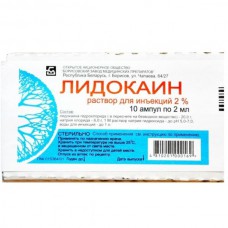Expiration dates: 07/2026
Composition
In 1 liter of solution for injection contains: lidocaine hydrochloride (calculated as anhydrous substance), 20 or 100 g,
Packaging
10 ampoules of 2 ml.
pharmachologic effect
Lidocaine is a local anesthetic, having also anti-arrhythmic activity. Assign with all kinds of local anesthesia: infiltration, conduction and surface. The anesthetic effect of lidocaine hydrochloride is 2-6 times stronger than novocaine. The drug blocks the current of sodium ions in the myocardial cells and suppresses the automaticity of ectopic foci, acts faster and longer. Reduces the effective refractory period, significantly reduces the amplitude of the action potential of myocardial cells. It has little effect on the electrophysiological properties of atrial and therefore ineffective in atrial cardiac arrhythmias forms. The drug has little effect on hemodynamics, only at high doses depresses myocardial contractility and intracardiac conduction.
testimony
Apply with a terminal (superficial) anesthesia mucous membranes (in urology, bronchoscopy, etc.), With infiltration anesteziivo time of surgery, anesthesia of the peripheral nerves (in dentistry, surgery, limbs and so on.), For the blockade of nerve plexus (brachial lumbar etc.), for epidural and spinal (spinal) anesthesia.
In an antiarrhythmic lidocaine hydrochloride used in the treatment of mono- and politopnye extrasystoles ventricular tachycardia (including those arising during general anesthesia during cardiac surgery with an overdose of cardiac glycosides and al.), For the relief of ventricular fibrillation in the acute phase of myocardial infarction and ventricular defibrillation as pharmacotherapy component. In addition, used to prevent arrhythmia and ventricular tachycardia any origin.
Contraindications
Sinus in elderly patients, intracardiac blockade II-III degree unless a probe to stimulate the ventricles), pronounced bradycardia, cardiogenic shock, severe liver function disorder, increased individual sensitivity to lidocaine hydrochloride.
Pregnancy and breast-feeding
During pregnancy and lactation is possible if the expected effect of therapy outweighs the potential risk to the fetus and child.
Dosing and Administration
Lidocaine dosage regimen set individually, depending on indications, clinical situation, and the dosage form. Arrhythmias: / jet (within 3-4 min) at a speed of 50-100 mg 25-50 mg / min, then drop at a speed of 4.1 mg / min. V / m at the rate of 4.3 mg / kg of body weight, if necessary again after 60-90 minutes. The maximum dose for adults with I / O and / m introduction - to 300-400 mg for 1 hour, maximum daily dose -. 2000 mg. Babies administered bolus 1 mg / kg at a rate of 25-50 mg / min, after 5 min possible re-introduction (total dose should not exceed 3 mg / kg). Then infused at 30 ug / kg / min. The maximum daily dose for children - 4 mg / kg. For surface anesthesia - 2.10% solution (less than 200 mg - 2 ml). In adults, for infiltration anesthesia using 0.5% solution for wire - 1-2% solution. The maximum total dose - 300-400 mg.
Side effects
With rapid intravenous possible the typical signs of overdose of lidocaine hydrochloride in the central nervous system in the form of euphoria, dizziness, flies flashing before the eyes, convulsive spasms of mimic muscles with the transition to klonikotonicheskie spasms of skeletal muscles, accompanied by violation of external respiration. Excess dosage of the drug leads to depression of the cardiovascular system as bradycardia, decrease in blood pressure, up to collapse.
special instructions
For extension of the anesthetic can add 1 drop of 0.1% solution of adrenaline 5-10 mL of lidocaine (the maximum tolerated dose increased to 500 mg).
Drug interactions
Co-administration with beta-blockers increase the risk of bradycardia, and toxic effects of lidocaine. Cimetidine and propranolol reduced hepatic clearance of lidocaine (decreased metabolism due to inhibition of microsomal oxidation and reduction of hepatic blood flow) and increase the risk of toxic effects. Barbiturates, phenytoin, rifampin (inducers of microsomal liver enzymes) reduce efficiency (increasing the dose may be required). In the appointment of aymalinu, phenytoin, verapamil, quinidine, amiodarone may increase the negative inotropic effect. Cardiac glycosides weaken cardiotonic effect Curariform drugs increase muscle relaxation. Procainamide increases the risk of central nervous system excitation, hallucinations. When concomitant administration of lidocaine, barbiturates and other hypnotics and sedative drugs may enhance their inhibitory action on the central nervous system. Under the influence of monoamine oxidase inhibitors may increase the action of local anesthetic lidocaine. Patients receiving monoamine oxidase inhibitors should not be administered parenterally lidocaine. With simultaneous application of lidocaine and polymyxin B may increase inhibitory effect on neuromuscular transmission (requires monitoring of respiratory function).
Overdose
Symptoms: The initial symptoms of poisoning - dizziness, nausea, vomiting, euphoria, fatigue, decreased blood pressure, and then - spasms of mimic muscles of the face, tonic-clonic spasms of skeletal muscles, agitation, bradycardia, collapse, when used in the delivery of the newborn - bradycardia, depression of the respiratory center, respiratory arrest.
Treatment: at the first signs of intoxication administration stopped, the patient is transferred to a horizontal position, administered oxygen inhalation. In convulsions - diazepam 10 mg intravenously. If bradycardia - m-holinoblokatory (atropine), vasoconstrictors (norepinephrine, phenylephrine). Perhaps intubation, mechanical ventilation, resuscitation. Dialysis is ineffective.
Storage conditions
In the dark place at a temperature no higher than 25 ° C.



